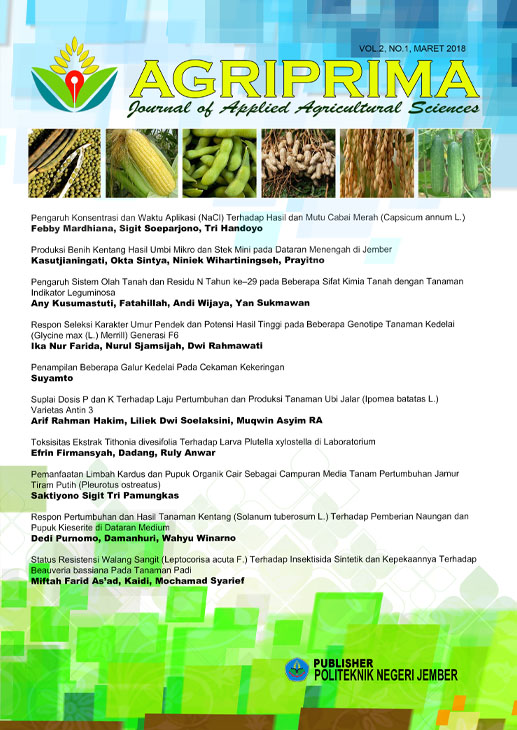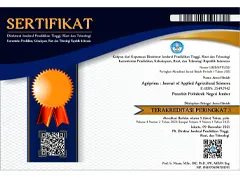Toksisitas Ekstrak Tithonia divesifolia Terhadap Larva Plutella xylostella di Laboratorium
DOI:
10.25047/agriprima.v2i1.82Downloads
Abstract
Plutella xylostella merupakan salah satu hamaoligofag yang menyerang tanaman family Brassicaceae. Pemakaian insektisda sintetik merupakan suatu metode pengendalian yang banyak dilakukan oleh petani. Penggunaan insektisida sintetik dapat mengakibatkan berbagai dampak negatif terhadap lingkungan. Salah satu upaya yang dapat dilakukan untuk meminimalkan dampak negatif tersebut adalah memanfaatkan bahan alami sebagai insektisida nabati. Tujuan penelitian ini adalah untuk mengetahui toksisitas dari ekstrak T. diversifolia terhadap larva P. xylostella. T. diversifolia yang digunakan yaitu daun dan bunga yang diekstrak dengan metanol dan etil asetat secara terpisah. Metode aplikasi yang digunakan yaitu metode residu pada daun, data mortalitas dianalisis dengan menggunakan analisis probit untuk memperoleh nilai LC50dan LC95. Hasil penelitian menunjukkan ekstrak metanol bunga T. diversifolia lebih toksik dibandingkan perlakuan lainnya dengan nilai LC50dan LC95berturut-turut 0,067 dan 0,826.
Keywords:
Insektisida nabati, Ramah Lingkungan, ToksisitasReferences
Capinera, J. L. (2001). Handbook of Vegetable Pests. California (US): Academic Press.
Castaño-Quintana, K., Montoya-Lerma, J., & Giraldo-Echeverri, C. (2013). Toxicity of Foliage Extracts of Tithonia diversifolia (Asteraceae) on Atta cephalotes (Hymenoptera: Myrmicinae) Workers. Industrial Crops and Products, 44, 391–395.
Cestari, I. M., Sarti, S. J., Waib, C. M., & Branco Jr., A. C. (2004). Evaluation of The Potential Insecticide Activity of Tagetes minuta (Asteraceae) Essential Oil Against The Head Lice Pediculus humanus capitis (Phthiraptera: Pediculidae). Neotropical Entomology, 33(6), 805–807.
Dadang, & Prijono, D. (2008). Insektisida Nabati: Prinsip, Pemanfaatan dan Pengembangan. Bogor (ID): Departemen Proteksi Tanaman, Institut Pertanian Bogor.
Dadang, & Prijono, D. (2011). Pengembangan teknologi formulasi insektisida nabati untuk pengendalian hama sayuran dalam upaya menghasilkan produk sayuran sehat. Jurnal Ilmu Pertanian Indonesia, 16(2), 100–111.
Gama, R. M. da, Guimarães, M., Abreu, L. C. de, & Armando-Junior, J. (2014). Phytochemical screening and antioxidant activity of ethanol extract of Tithonia diversifolia (Hemsl) A. Gray dry flowers. Asian Pacific Journal of Tropical Biomedicine, 4(9), 740–742.
Mkenda, P. A., Mtei, K., & Ndakidemi, P. A. (2014). Pesticidal efficacy of Tephrosia vogelii and Tithonia diversifolia against field insect pests of common beans [Phaseolus vulgaris L.] within African farming communities. African Journal of Applied Agricultureal Sciences and Technologies, 2, 9–26.
Mkenda, P., & Ndakidemi, P. (2014). Pesticidal Efficacy of Four Botanical Pesticides on Survival, Oviposition and Progeny Development of Bruchid, Callosobruchus maculatus in Stored Cowpea, Vigna unguiculata. International Journal of Plant & Soil Science, 3(12), 1504–1523.
Mukasa, D., Olila, D., Tinzaara, W., & Kagezi, G. H. (2008). Effects of Tithonia and Phytolacca extracts against the banana weevil, Cosmopolites sordidus (Germar) (Coleoptera: Curculionidae). AJABS, 3(1), 24–29.
Software LeOra. (1987). POLO-PC: A User’s Guide to Probit Logit Analysis. Berkely, CA, USA.
War, A. R., Paulraj, M. G., Hussain, B., Buhroo, A. A., Ignacimuthu, S., & Sharma, H. C. (2013). Effect of plant secondary metabolites on legume pod borer, Helicoverpa armigera. Journal of Pest Science, 86(3), 399–408.
License
Copyright (c) 2018 Efrin Firmansyah, FNU Dadang, Ruly Anwar

This work is licensed under a Creative Commons Attribution-ShareAlike 4.0 International License.
You are free to:
- Share — copy and redistribute the material in any medium or format.
- Adapt — remix, transform, and build upon the material for any purpose, even commercially.
Under the following terms:
- Attribution — You must give appropriate credit, provide a link to the license, and indicate if changes were made. You may do so in any reasonable manner, but not in any way that suggests the licensor endorses you or your use.
- ShareAlike — If you remix, transform, or build upon the material, you must distribute your contributions under the same license as the original.
- No additional restrictions — You may not apply legal terms or technological measures that legally restrict others from doing anything the license permits.









